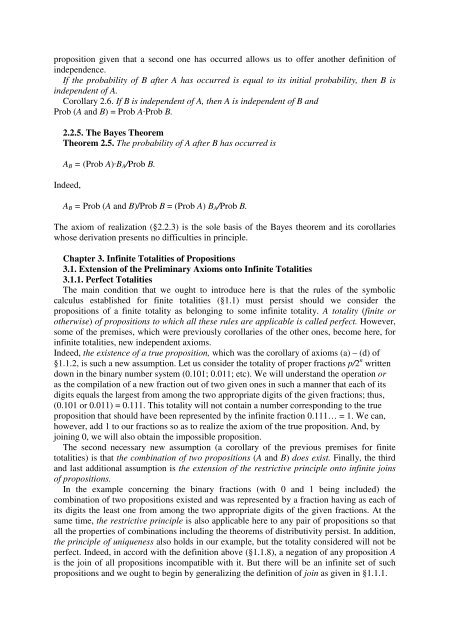kniga 7 - Probability and Statistics 1 - Sheynin, Oscar
kniga 7 - Probability and Statistics 1 - Sheynin, Oscar
kniga 7 - Probability and Statistics 1 - Sheynin, Oscar
Create successful ePaper yourself
Turn your PDF publications into a flip-book with our unique Google optimized e-Paper software.
proposition given that a second one has occurred allows us to offer another definition ofindependence.If the probability of B after A has occurred is equal to its initial probability, then B isindependent of A.Corollary 2.6. If B is independent of A, then A is independent of B <strong>and</strong>Prob (A <strong>and</strong> B) = Prob AProb B.2.2.5. The Bayes TheoremTheorem 2.5. The probability of A after B has occurred isA B = (Prob A)B A /Prob B.Indeed,A B = Prob (A <strong>and</strong> B)/Prob B = (Prob A) B A /Prob B.The axiom of realization (§2.2.3) is the sole basis of the Bayes theorem <strong>and</strong> its corollarieswhose derivation presents no difficulties in principle.Chapter 3. Infinite Totalities of Propositions3.1. Extension of the Preliminary Axioms onto Infinite Totalities3.1.1. Perfect TotalitiesThe main condition that we ought to introduce here is that the rules of the symboliccalculus established for finite totalities (§1.1) must persist should we consider thepropositions of a finite totality as belonging to some infinite totality. A totality (finite orotherwise) of propositions to which all these rules are applicable is called perfect. However,some of the premises, which were previously corollaries of the other ones, become here, forinfinite totalities, new independent axioms.Indeed, the existence of a true proposition, which was the corollary of axioms (a) – (d) of§1.1.2, is such a new assumption. Let us consider the totality of proper fractions p/2 n writtendown in the binary number system (0.101; 0.011; etc). We will underst<strong>and</strong> the operation oras the compilation of a new fraction out of two given ones in such a manner that each of itsdigits equals the largest from among the two appropriate digits of the given fractions; thus,(0.101 or 0.011) = 0.111. This totality will not contain a number corresponding to the trueproposition that should have been represented by the infinite fraction 0.111… = 1. We can,however, add 1 to our fractions so as to realize the axiom of the true proposition. And, byjoining 0, we will also obtain the impossible proposition.The second necessary new assumption (a corollary of the previous premises for finitetotalities) is that the combination of two propositions (A <strong>and</strong> B) does exist. Finally, the third<strong>and</strong> last additional assumption is the extension of the restrictive principle onto infinite joinsof propositions.In the example concerning the binary fractions (with 0 <strong>and</strong> 1 being included) thecombination of two propositions existed <strong>and</strong> was represented by a fraction having as each ofits digits the least one from among the two appropriate digits of the given fractions. At thesame time, the restrictive principle is also applicable here to any pair of propositions so thatall the properties of combinations including the theorems of distributivity persist. In addition,the principle of uniqueness also holds in our example, but the totality considered will not beperfect. Indeed, in accord with the definition above (§1.1.8), a negation of any proposition Ais the join of all propositions incompatible with it. But there will be an infinite set of suchpropositions <strong>and</strong> we ought to begin by generalizing the definition of join as given in §1.1.1.









